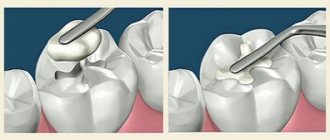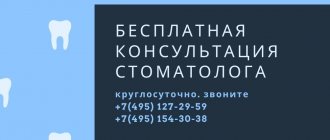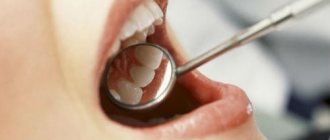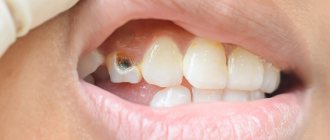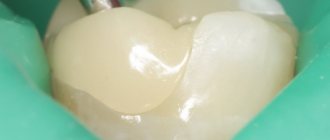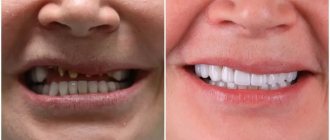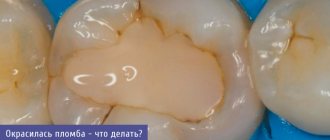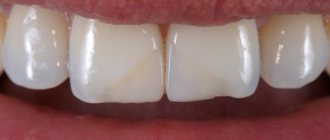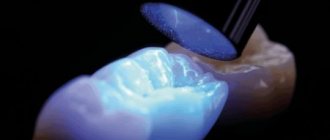Fillings made from glass ionomer cement (in particular, “Evicrol”) are designed to imitate and replenish native tooth tissues that were lost during treatment or traumatic damage. They are well suited for small cavities with moderate or superficial caries. Despite their high strength characteristics, they have an affordable price and are also able to withstand intense loads created during the chewing process. Along with good aesthetic characteristics, this makes them ideal for the restoration of chewing teeth.
Therapists at the dental department of CELT widely use glass ionomer composite fillings to restore dental tissues. They use materials that have proven themselves in many years of practical use. Along with adherence to technological processes, this allows us to obtain beautiful and functional restorations with a long service life. You can find out the cost of fillings in the price list by going to the “Services and prices” tab. Despite the fact that we regularly update it, we recommend that you check the numbers by contacting our information line operators or visiting a doctor.
Consultation with a dentist-therapist - 1,000 rubles.
Filling made of glass ionomer cement or Evicrol - 2,000 rubles.
At CELT you can get advice from a dental specialist.
- The cost of a consultation with a dentist-therapist is 1,000
Make an appointment
Features and advantages of glass ionomer cement fillings
A distinctive feature of orthopedic structures made of glass ionomer material is that they harden due to a chemical reaction that is triggered by mixing powder and liquid. The latter consists of tartaric acid and distilled water, while the former includes:
- Crushed glass (silicon dioxide), which causes transparency, makes hardening less rapid and prolongs the service life of the restoration;
- Calcium fluoride, which is necessary to prevent the development of secondary carious processes;
- Aluminum phosphate, which makes the filling more durable and resistant to mechanical stress;
- Aluminum oxide, which causes immunity to the destructive effects of acids;
- Barium salts, which make the filling visible on x-rays.
Unlike fillings made of light-curing composite, structures made of GIC are several times cheaper. Their service life is from 10 to 15 years. Other benefits:
- Excellent strength characteristics, high hardness;
- Ease of use/high speed of restoration production;
- Uniform hardening, regardless of the size and depth of the carious cavity;
- Immunity to saliva and acids;
- Minimal risk of filling cracking;
- Minimum shrinkage: no more than 3.5%.
No. 4 Expensive-cheap: light-polymer fillings
A smaller filling will preserve the vitality of the tooth, and the cost of treatment will be minimal.
The final stage of treatment of caries and its complications is tooth filling, i.e.
filling the tooth cavity with filling material in order to restore the anatomical shape and physiological function of the tooth. “These are expensive fillings, but at the same time they are of the highest quality.”
The Reutdent and Dentblanc clinics use the latest filling materials -
light polymers
.
The peculiarity of light polymers is that they pass into the solid stage only under the influence of an ultraviolet lamp. This means that the dentist has much more time to fill the carious cavity efficiently and layer by layer and model the shape of the tooth. In addition, they have a wide variety of shades and are very durable; these are expensive fillings, but at the same time they are of the highest quality. Using the table below, you can familiarize yourself with the features of filling materials used in our clinics. Characteristics of filling materials
| № | Material name | Advantages | Flaws |
| 1 | Esthet•X “Esthet – x” | Light-curing, radiopaque composite material for the restoration of the anterior and lateral groups of teeth, both in the permanent and primary dentition, occupies a leading position in modern dentistry, allows you to completely restore the anatomical shape of the teeth, a wide range of colors, polishing the enamel to a shine, and is resistant to abrasion. | Hardness is higher than tooth hardness. |
| 2 | Filtek™ Ultimate Filtek Ultimate | ||
| 3 | Сharisma Charisma | It is a chemically cured filling material and is used as a cushioning material, non-flowing (pasty), with good adhesion and abrasion resistance, polished to a shine. | A small number of colors and limited time for mixing the filling, which affects the quality of treatment. |
| 4 | SonicFill system Sonic Fill | An innovative system that allows you to quickly, easily and reliably restore the shape of a tooth using a special tip. | |
| 5 | Filtek Z250 Filtek Z 250 | The advantages are the same as other light-curing fillings. This is not an expensive material. | It is impossible to polish to a shine, therefore it is used mainly when filling the chewing group of teeth. |
The table does not contain a description of cements, which are no longer used in our clinics, since cements have significant disadvantages and entail consequences in the form of secondary caries processes.
The final price of tooth filling depends on the cost of the material, and if a more modern and innovative one is used, then the treatment of caries will be more expensive.
Material "Filtek Z250"
has the most affordable price and, due to its properties, is used in a budget treatment option.
“Sonic Fill”
is a material that is applied with a special tip only to the chewing teeth.
The good thing about the material is that it can be used to create the exact shape of a tooth, it matches the color well and is well polished, the filling acquires a shine similar to the color of the tooth itself. It is almost not subject to abrasion, so it is used on chewing teeth. “Ceramic inlays are made in the laboratory.”
Materials such as
Estet•X, Supreme
and
Charisma are used for the restoration of anterior teeth, as they are well polished and retain their shine. Modern materials make it possible to eliminate the transition between the filling and the tooth, and as a result, the filled tooth looks natural. Ceramic inlays are placed on vital (living, non-pulpless) teeth. To do this, first an impression is taken, then an inlay is prepared from it in the laboratory. The shape of the inlay is reproduced on the model, which makes it possible to replicate the anatomy of the tooth and ensures high-quality contact with antagonist teeth. The inlays are wear-resistant, do not wear off at all and perfectly match the color of the tooth tissue. A ceramic inlay is more expensive than a light-curing material, since the price includes the work of a ceramic technician, but the ceramic itself is much harder. Depending on the tooth decay, the doctor decides which material should be chosen and offers treatment options to the patient. Let us emphasize once again that by visiting a doctor for a preventive examination, when nothing is bothering you yet, you can identify caries at a very early stage, while a small amount of hard tooth tissue is affected. In this case, the filling will be smaller, which will preserve the vitality of the tooth, and the cost of treatment will be optimal.
Reviews about our dental therapists
I would like to express my gratitude to the dentist Elena Nikolaevna Kiseleva and her assistant Svetlana - they are real specialists and at the same time sensitive, not burnt out by years of practice.
Thanks to them, I have been coming back here for many years. Thanks to the management for such doctors! Read full review Svetlana Nikolaevna
13.08.2021
Words cannot express my gratitude to Elena Nikolaevna Kiseleva. This is the best doctor in the world. I got an appointment after many years of being ignored by the dentist’s office and with a bitter experience of treatment in another paid clinic, the mistakes of which had to be corrected in the first visits. Thank you for this... Read full review
Roman Stanislavovich Sh
25.07.2020
Evicrol
Manufacturer: SpofaDental
Product code: 21893 Quantity: Help and Order: 979-59-64
PRICE
0.00
RUR.
Found it cheaper?
Let's reduce the price! MORE THAN 2 pcs. 0.00
Rub.
MORE THAN 5 pcs. 0.00
Rub.
| Evicrol is a two-component filling material for the production of permanent fillings based on methyl methacrylate. |
Indications:
— filling of hard tissue defects of non-carious etiology — fixation of splints — restoration of the stump Application: Powder and liquid are mixed with a plastic spatula on special paper until a paste-like state. In most cases, 2 drops of liquid and 2 spoons of powder are enough for one filling. Mixing is done quickly (within 30 - 40 s). For better adhesion of Evicrol and enamel, the edges of the cavity are beveled at an angle of 45° and the enamel surrounding the cavity is etched for 1 minute. Filling is carried out in 1 minute. (The appearance of the filling improves, and its reliability increases, if polymerization occurs under a matrix, plastic plate or cap.) Within 2 minutes, the mixture hardens and is left alone. Then the matrix or cap is removed and after 3 minutes the filling is finished.
Manufacturer: Spofa Dental
INSTRUCTIONS FOR USE "EVICROL"
Composite filling material Manufacturer: SpofaDental JSC, Markova 238, Czech Republic – 506 46 Jicin,
Compound:
powdered component: silanized silicon dioxide, benzoyl peroxide, pigments
liquid component: Elaxy B
Characteristics: Composite filling material, consisting of two parts, is intended for the production of permanent aesthetic fillers.
Manufactured in 4 color shades (main shade No. 21 and three additional shades: No. 25, No. 27, No. 45). The basis of the material is a combination of high molecular weight substances with a transparent inorganic filler. By firmly combining both components with a chemical bond, good physical and chemical properties were achieved, which give the material the possibility of many-sided applications.
Indications: EVICROL® has mechanical properties approaching those of amalgam, which significantly expands the possibilities of its use in dentistry. Most often, EVICROL® is used for the manufacture of fillers of the third and fifth classes according to Black (caries on adjacent contacting surfaces of incisors, canines and dental necks). In addition, EVICROL® can also be used for corner defects (fourth class).
Contraindications: The material is unsuitable for use in more remote places with increased load. Side effects: not described.
Manufacturing: - The mass is prepared by mixing the powder with liquid on notepad paper using a rubbing plastic spatula. It is not recommended to mix with a metal rubbing spatula because the metal will be abraded, resulting in coloration of the composite material. We achieve the correct ratio of the mixture by dosing the same number of drops of liquid and filling measuring containers of powder flush with the edges. In most cases, start from 2 drops of liquid and 2 filled measuring containers of powder flush with the edges. The mass volume is 1.5 g of powder and 0.5 g of liquid. The mixed mixture has a paste-like character, the surface of the mixed mass is slightly matte and when removing the rubbing spatula it is easily pulled out. It takes approximately 30 to 40 seconds to mix a dose of Evicrol with 2 drops of liquid. The stirred mixture remains workable at mouth temperature for approximately 1 minute. Then hardening begins (preferably under the matrix), which lasts approximately 2 minutes. During this time, it is necessary to leave the filler at rest, and after a further 3 minutes, carry out the necessary processing. The defective tooth hole will be treated in the usual way. It is beneficial to slightly bevel the surface of the tooth enamel to increase the area of its contact with the material. — For laying under EVICROL®, conventional backing materials are used, such as zinc phosphate cement ADGEZOR or polycarboxylate cement ADGESORCARBOFINE. Zinc oxide-eugenol cement CARIOSAN® must not be used. The backing material must cover the entire surface of the exposed dentin! After the base material has hardened, the enamel edges of the tooth are etched with a caustic solution of EVICROL® (part of the packaging), which is applied using a piece of cotton wool and left to act for 60 seconds. Effective etching of tooth enamel is the main condition for the microretention attachment of the Evicrol dental filler to the enamel. In practice, etching will manifest itself in the form of matting of the surface of tooth enamel. In some cases, with very resistant tooth enamel, it is necessary to repeat the etching. The caustic solution is eliminated by thorough rinsing with water (10 - 20 seconds). - After drying, the defective hole in the tooth will be filled with Evicrol with a slight excess. The highest quality surface of the filler will be obtained when hardening under a cellulose strip (cellulose acetate), for example, at a defective hole of the third class, under a plastic film (for defective dental holes of the first class with clenched teeth), or under matrices (for defective holes of the fifth and fourth classes ). After 2 minutes of hardening, you can remove the film, and after a further 3 minutes, treat the prepared filler with a block or polish it with “DEPURAL® NEO pasta” mixed with Vaseline. With the correct working method (non-excessive thickening of the mixture, well-etched tooth enamel), the Evicrol filler will reliably and firmly connect to the tooth enamel using a microretention method. Warning: Do not use in close proximity to soft tissue. Waste disposal: Dispose of unused excess powder and packaging with regular waste. The liquid should be transferred to a company authorized to handle waste or should be disposed of by burning hazardous substances. Do not pour liquid down the drain.
Storage: In a dry and dark place at a temperature of 5 to 25 C in a well-closed package.
Shelf life: 2 years
Packaging: 1 x 40 g powder - main shade No. 213 x 10 g powder - additional shades No. 25, No. 27 and No. 451 x 26 g liquid 1 x 14 g EVICROL® caustic solution 25 pestles for rubbing 2 notebooks of rubbing papers 2 measuring spoons for powder
Previous product
Next product
Evicrol Evicrol - chemical composite Spofa Dent
Dental filling material Evicrol.
Known in our market for more than 30 years.
It is used as the main filling material for teeth.
- filling of hard tissue defects of non-carious etiology
- tire fixation
- stump restoration Application Powder and liquid are mixed with a plastic spatula on special paper until paste-like. In most cases, 2 drops of liquid and 2 spoons of powder are enough for one filling. Mixing is done quickly (within 30 - 40 s). For better adhesion of Evicrol and enamel, the edges of the cavity are beveled at an angle of 45° and the enamel surrounding the cavity is etched for 1 minute. Filling is carried out in 1 minute. (The appearance of the filling improves, and its reliability increases, if polymerization occurs under a matrix, plastic plate or cap.) Within 2 minutes, the mixture hardens and is left alone. Then the matrix or cap is removed and after 3 minutes the filling is finished.
Manufacturer: Spofa Dental
INSTRUCTIONS FOR USE "EVICROL"
Composite filling material Manufacturer: SpofaDental JSC, Markova 238, Czech Republic – 506 46 Jicin,
Compound:
powdered component: silanized silicon dioxide, benzoyl peroxide, pigments
liquid component: Elaxy B Characteristics: Composite filling material, consisting of 2 parts, intended for the production of permanent aesthetic fillers.
Manufactured in 4 color shades (main shade No. 21 and three additional shades: No. 25, No. 27, No. 45). The basis of the material is a combination of high molecular weight substances with a transparent inorganic filler. By firmly combining both components with a chemical bond, good physical and chemical properties were achieved, which give the material the possibility of many-sided applications. Indications: EVICROL® has mechanical properties approaching those of amalgam, which significantly expands the possibilities of its use in dentistry. Most often, EVICROL® is used for the manufacture of fillers of the third and fifth classes according to Black (caries on adjacent contacting surfaces of incisors, canines and dental necks). In addition, EVICROL® can also be used for corner defects (fourth class). Contraindications: The material is unsuitable for use in more remote places with increased load. Side effects: not described. Manufacturing: - The mass is prepared by mixing the powder with liquid on notepad paper using a rubbing plastic spatula. It is not recommended to mix with a metal rubbing spatula because the metal will be abraded, resulting in coloration of the composite material. We achieve the correct ratio of the mixture by dosing the same number of drops of liquid and filling measuring containers of powder flush with the edges. In most cases, start from 2 drops of liquid and 2 filled measuring containers of powder flush with the edges. The mass volume is 1.5 g of powder and 0.5 g of liquid. The mixed mixture has a paste-like character, the surface of the mixed mass is slightly matte and when removing the rubbing spatula it is easily pulled out. It takes approximately 30 to 40 seconds to mix a dose of Evicrol with 2 drops of liquid. The stirred mixture remains workable at mouth temperature for approximately 1 minute. Then hardening begins (preferably under the matrix), which lasts approximately 2 minutes. During this time, it is necessary to leave the filler at rest, and after a further 3 minutes, carry out the necessary processing. The defective tooth hole will be treated in the usual way. It is beneficial to slightly bevel the surface of the tooth enamel to increase the area of its contact with the material. — For laying under EVICROL®, conventional backing materials are used, such as zinc phosphate cement ADGEZOR or polycarboxylate cement ADGESORCARBOFINE. Zinc oxide-eugenol cement CARIOSAN® must not be used. The backing material must cover the entire surface of the exposed dentin! After the base material has hardened, the enamel edges of the tooth are etched with a caustic solution of EVICROL® (part of the packaging), which is applied using a piece of cotton wool and left to act for 60 seconds. Effective etching of tooth enamel is the main condition for the microretention attachment of the Evicrol dental filler to the enamel. In practice, etching will manifest itself in the form of matting of the surface of tooth enamel. In some cases, with very resistant tooth enamel, it is necessary to repeat the etching. The caustic solution is eliminated by thorough rinsing with water (10 - 20 seconds). - After drying, the defective hole in the tooth will be filled with Evicrol with a slight excess. The highest quality surface of the filler will be obtained when hardening under a cellulose strip (cellulose acetate), for example, at a defective hole of the third class, under a plastic film (for defective dental holes of the first class with clenched teeth), or under matrices (for defective holes of the fifth and fourth classes ). After 2 minutes of hardening, you can remove the film, and after a further 3 minutes, treat the prepared filler with a block or polish it with “DEPURAL® NEO pasta” mixed with Vaseline. With the correct working method (non-excessive thickening of the mixture, well-etched tooth enamel), the Evicrol filler will reliably and firmly connect to the tooth enamel using a microretention method. Warning: Do not use in close proximity to soft tissue. Waste disposal: Dispose of unused excess powder and packaging with regular waste. The liquid should be transferred to a company authorized to handle waste or should be disposed of by burning hazardous substances. Do not pour liquid down the drain. Storage: In a dry and dark place at a temperature of 5 to 25 C in a well-closed package. Shelf life: 2 years Packaging: 1 x 40 g powder - main shade No. 213 x 10 g powder - additional shades No. 25, No. 27 and No. 451 x 26 g liquid 1 x 14 g EVICROL® caustic solution 25 pestles for rubbing 2 pads of papers for rubbing 2 measuring spoons for powder
Gutta-percha is a hard and at the same time elastic product of coagulation of the latex of gutta-percha-bearing tropical plants. Contains up to 90% high molecular weight trans-polyisoprene (natural rubber contains cis-polyisoprene). The production of gutta-percha products is concentrated in Southeast Asia, Korea, and Brazil. In Russia, the source of gutta-percha is the warty euonymus. When heated (50-100 degrees), gutta-percha softens and becomes plastic. Gutta-percha is divided into 2 types - alpha and beta, which differ in physical characteristics. For the production of gutta-percha points, beta-gutta-percha is usually used, which is more hard and has a higher softening point.
However, recently, more plastic alpha-gutta-percha has become increasingly popular, which, when heated, provides a more homogeneous filling of the root canal system and is used in techniques that involve working with thermoplasticized (heated) gutta-percha. In addition, there is a special, patented type of gutta-percha used in Soft-Core systems. Gutta-percha points used for filling root canals consist of gutta-percha itself (20%), zinc oxide (60-70%), barium sulfate (radiopaque agent), wax and other additives. The main advantages of gutta-percha are good biocompatibility, low toxicity, the possibility of reliable three-dimensional filling of the canal system in a heated state, spatial stability in the hardened state and ease of removal from the root canal if re-treatment is necessary.
The disadvantages of gutta-percha include: lack of adhesion to dentin, lack of bactericidal properties. Until recently, the main method of filling root canals was the method of filling with one paste, which has a number of disadvantages (uneven filling of the main canal and its branches, shrinkage of the paste, resorption of the paste upon contact with tissue fluid, etc.).
Now the main method is filling root canals with gutta-percha using sealers (pastes). The sealer acts not only as an additional sealant that fills the root canal system and ensures adhesion of gutta-percha to the canal walls, but also as a substance that ensures free sliding of gutta-percha pins in the root canal during filling.
